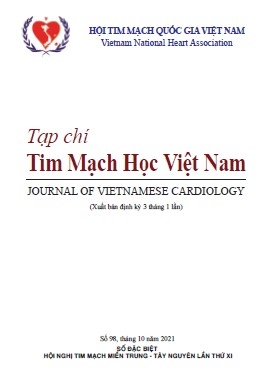Nghiên cứu mối tương quan các yếu tố nguy cơ tim mạch với mức độ giãn động mạch vành sau khi bơm nitroglycerin trực tiếp động mạch vành
DOI:
https://doi.org/10.58354/jvc.98.2021.107Tóm tắt
Đặt vấn đề: Trong hội chứng vành cấp, co thắt ĐMV là nguyên nhân của 49% trường hợp và xuất hiện ở 30% trường hợp không có tổn thương thủ phạm. Bên cạnh đó, việc loại bỏ tình trạng co thắt ĐMV bằng Nitroglycerin trên đoạn hẹp và cả đoạn không hẹp giúp đánh giá trung thực hơn mức độ hẹp (%) khẩu kính của tổn thương.
Đối tượng nghiên cứu: 40 bệnh nhân được chẩn đoán bệnh tim thiếu máu cục bộ.
Phương pháp nghiên cứu: Mô tả cắt ngang với cỡ mẫu thuận tiện.
Kết quả: Không có mối liên quan giữa mức độ giãn đường kính lòng mạch nhỏ nhất với các yếu tố nguy cơ tim mạch cơ bản. Về mặt đường kính, mức độ giãn tại vị trí lòng mạch nhỏ nhất (25,37 ± 18,19 %) nhiều hơn so với mức độ giãn lòng mạch tham chiếu (6,47 ± 7,60 %), với giá trị p<0,001. Kết quả tương tự cũng được tìm thấy đối với diện tích ĐMV khảo sát. Có mối tương quan mức độ trung bình giữa độ giãn lòng mạch nhỏ nhất và độ giãn lòng mạch tham chiếu ở cả thông số đường kính và diện tích lòng mạch.
Kết luận: Có mối tương quan giữa độ giãn lòng mạch nhỏ nhất và độ giãn lòng mạch tham chiếu sau khi bơm Nitroglycerin nhưng không có mối liên quan với các yếu tố nguy cơ tim mạch.
Từ khóa: Co thắt, động mạch vành, nitroglycerin, yếu tố nguy cơ.
Tài liệu tham khảo
1. AkihiroMasumotoetal.(2001).Effect of Pravastatin on Endothelial Function in Patients With Coronary Artery Disease (Cholesterol- Independent Effect of Pravastatin). The American Journal of Cardiology. 88(11), 1291–1294.
![]()
2. Auerbach, O. et al. (1968). Thickening of Walls of Arterioles and Small Arteries In Relation to Age and Smoking Habits. The New England Journal of Medicine. 278(18), 980–984.
![]()
3. Avogaro, A. et al. (2011). Endothelial dysfunction in diabetes: The role of reparatory mechanisms. Diabetes Care. 34(SUPPL. 2), 285–290.
![]()
4. Caballero, A.E. et al. (1999). Microvascular and macrovascular reactivity is reduced in subjects at risk for type 2 diabetes. Diabetes. 48(9), 1856–1862.
![]()
5. Egashira, K. et al. (1993). Effects of age on endothelium-dependent vasodilation of resistance coronary artery by acetylcholine in humans. Circulation. 88(1), 77–81.
![]()
6. Foley, D.P. et al. (1994). Quantitative coronary angiography (QCA) in interventional cardiology: Clinical application of QCA measurements. Progress in Cardiovascular Diseases. 36(5), 363–384.
![]()
7. Gao,Z.etal.(2012).Altered coronary vascular control during cold stress in healthy older adults.American Journal of Physiology - Heart and Circulatory Physiology. 302(1), 312–318.
![]()
8. Garrone, P. et al. (2009). Quantitative coronary angiography in the current era: Principles and applications. Journal of Interventional Cardiology. 22(6), 527–536.
![]()
9. Gaspardone A et al. (2002). The Enhanced Vasoreactivity of the Culprit an Increased Local Release of Endothelin-1. Journal of Clinical and Basic Cardiology. 5(1), 87–92.
![]()
10. Hadi, H.A.R. et al. (2005). Endothelial dysfunction: cardiovascular risk factors, therapy, and outcome. Vascular health and risk management. 1(3), 183–198.
![]()
11. JassimAlSuwaidietal.(2001).Obesity is independently associated with coronary endothelial dysfunction in patients with normal or mildly diseased coronary arteries. Journal of the American College of Cardiology. 37(6), 1523–1528.
![]()
12. KangL.S.,ReyesR.A.andMuller-DelpJ.M.(2009).Aging impairs flow-induced dilation in coronary arterioles: Role of NO and H2O2. American Journal of Physiology - Heart and Circulatory Physiology. 297(3), H1087–H1095.
![]()
13. Maron D.J., Hochman J.S., Reynolds H.R., et al. (2020). Initial invasive or conservative strategy for stable coronary disease. New England Journal of Medicine. 382(15), 1395–1407.
![]()
14. Ong, P. et al. (2008). Coronary Artery Spasm as a Frequent Cause of Acute Coronary Syndrome. The CASPAR (Coronary Artery Spasm in Patients With Acute Coronary Syndrome) Study. Journal of the American College of Cardiology. 52(7), 523–527.
![]()
15. R.DavidAndersonandCarlJ.Pepine(2013).Coronary Angiography: Is it Time to Reassess?Circulation. 127(17), 1760–1762.
![]()
16. Tomai,F.etal.(2001).Unstable angina and elevated C-reactive protein levels predict enhanced vasoreactivity of the culprit lesion. Circulation. 104(13), 1471–1476.
![]()
17. Treasure, C.B. et al. (1993). Hypertension and left ventricular hypertrophy are associated with impaired endothelium-mediated relaxation in human coronary resistance vessels. Circulation. 87(1), 86–93.
![]()
Tải xuống
Đã Xuất bản
Các phiên bản
- 03-03-2023 (2)
- 03-03-2023 (1)








